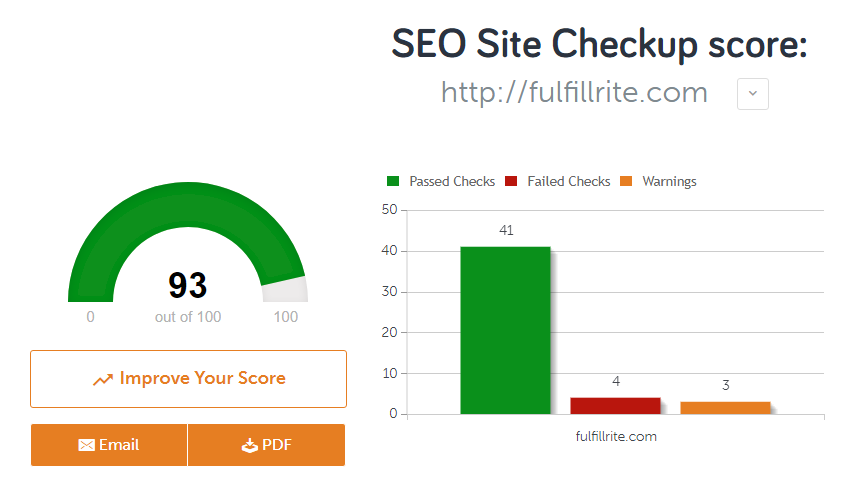When running an eCommerce store, one of the most attractive ways to earn sales is by improving your ranking in search engines like Google. Once you establish a foothold in the search engine results, it becomes much easier to pull in traffic.
What is SEO?
The process of improving your search engine ranking is called SEO. It’s short for search engine optimization. There are a lot of ways that you can optimize your website for search engine traffic, and we’ll spend most of this article providing concrete tips you can use.
Suffice it to say that search engines these days are pretty smart. They weigh factors ranging from behind-the-scenes technical setup to load time to overall user experience. When the Internet was younger, you could simply pack pages full of keywords and watch your Google rank rise. It’s not that simple anymore, and thank goodness – the Internet is full of better, more well-run websites because of it.
Why is SEO Important?
Ecommerce sales have been rising steadily, particularly because of the pandemic. However, the eCommerce process doesn’t just start when a customer lands on your website. The purchasing process involves them finding you in the first place!
The two biggest ways for customers to find your eCommerce website are search engine queries and social media. In fact, if you take the massive 18,000-store Yotpo database, 30.5% of traffic was coming in from organic Google searches alone. That’s a staggeringly high figure, and it’s not at all uncommon for specific stores to pull more than half of their traffic from search engines.
It’s a cost-efficient form of marketing too. According to Points Group, for every $1 spent trying to get the #1 ranking on Google, they earned $4.76 back. That’s a really solid ROI for a marketing initiative.
Consider the following as well. Once you have traffic steadily dripping in without your conscious effort, you can focus on other revenue-generating work as well. For example, once you have steady traffic, you can focus on customer retention and reducing shopping cart abandonment rate.
16 Practical Tips to Improve SEO for Your eCommerce Store
1. Research and use great keywords.
The trick with SEO, if you can even call it a trick, is you want to land as high as possible in the search engine results. How can you reliably do that? You track down obscure and super-specific keywords and aim to rank high for those.
These obscure, super-specific keywords are known as “long-tail keywords.” Search Engine Journal uses the example “bed sheets that keep you cool” to describe long-tail keywords.
As you can imagine, if you rank well for “bed sheets that keep you cool,” then your odds of ranking high are much better than they would be for just “bed sheets.” The conversion rate is likely to be much better too.
Picking great SEO keywords could be an article all on its own, but here are some basic principles to follow:
- Come up with a few categories of keywords for which you’d like your pages to rank.
- Use the Google Keyword Planner to get keyword ideas.
- Look for keywords that have more than four words.
- Check Google and Amazon’s autosuggestions.
- Check out your competitor’s keywords.
2. Improve your website architecture.
Have you ever gone to a website and had a hard time finding what you’re looking for? Google will ding you in the search results for that.
Your website needs to be laid out in such a way where people can get to whatever they’re looking for in the fewest possible clicks. Three or less is ideal.
If you have a big eCommerce store and need to give people a way to narrow down their options, add filters to your page. This will allow shoppers to find what they are looking for without navigating away from the page.
3. Use SEO Site Checkup to find SEO issues.

SEO Site Checkup is one of our favorite free tools for optimizing your website’s SEO. Just go to their website, type in your website’s URL, and run SEO Site Checkup. Once you do that, you will receive a free report with specific instructions on how to improve your SEO. Follow their advice!
4. Optimize your website for mobile devices.
People are using mobile devices more and more with each passing year. You should generally assume that people are accessing your website on their phone. If your website is not well-designed for mobile devices, that’s going to create a bad user experience. If you do that, then you will drop in the Google search results.
According to Moz, here are a few tips on how to best create websites for mobile devices:
- Don’t use Flash.
- Don’t use pop-ups.
- Place clickable items far enough away on the screen for “fat fingers.”
- Use concise page titles and URLs.
- Optimize for local search.
5. Use search engine markup.
Have you ever seen Google search results that look like this?

How about this?

The former example uses what’s called “product schema markup” and the latter uses “review schema markup.”
While you do need to know a little bit about HTML in order to implement this particular kind of SEO on your website, it’s worth knowing about!
Here are a few resources where you can learn more:
6. Use HTTPS and not HTTP.
HTTPS uses encryption to help keep your shoppers safe. More and more websites are using HTTPS instead of HTTP in their URLs these days, and it’s really important to follow this trend. If you do this, then browsers like Chrome will display a padlock next to your website URL.
HTTPS doesn’t swing the search engine rankings too much, but it does make a difference. You can use the website Why No Padlock to help you figure out why your website does not have HTTPS if it does not currently.
7. Reduce 404 errors.
If you go to a page and it says “404”, then that means the page doesn’t exist. Landing on a 404 is really annoying to customers, and you want to keep this from happening if at all possible.
That doesn’t mean that you should indiscriminately remove 404 errors by redirecting people automatically from dead pages to your home page. Rather, you should use tools like Google Search Console to figure out when people are landing on pages that don’t exist. You can then redirect them to the next closest page.
8. Improve website speed.
Google considers site speed and page speed when determining how to rank pages. Faster pages and websites tend to rank higher. That means you need your website to load as quickly as possible. Here are a few best practices to follow:
- Compress large images and other files.
- Minify CSS, JavaScript, and HTML.
- Install a browser caching plugin.
- Optimize images to load faster.
9. Make a sitemap.
Sitemaps are simple files that allow search engines like Google to quickly read the contents of a website. Most eCommerce software, as well as content management systems like WordPress, will allow you to create a sitemap pretty easily. Take a little time to set that up – it’s an easy way to improve your SEO!
10. Write detailed product descriptions.

It’s a well-establish fact that long-form content ranks better in Google. The general rule of thumb which many SEO experts advocate is “write 1,000 or more words.”
While that may seem intimidating, there are a few reasons for this. First, writing over 1,000 words gives you more chances to include relevant keywords on your page. Second, longer product descriptions are more useful to customers and therefore provide a better user experience.
If you write long product descriptions, you can also take heart in knowing that reviews from customers will likely further increase the count of words on your page, thus further improving SEO.
11. Claim your Google My Business profile.
This is a relatively easy step. Go to Google My Business, enter in your business’s details and…that’s it! Within a few hours, when people Google your business, they will be able to access your website, its information, your hours, and other relevant details!
12. Reach out to your local media.
More and more people are using mobile phones. That means that location-specific inquiries on search engines are becoming more common. This has created a subset of SEO known as local SEO.
To improve your search engine ranking for local inquiries, start by reaching out to your local media. This can help you to build links that are relevant to community in which your business is based.
13. Use content marketing.
We’ve talked about content marketing before, but it’s so important that it bears repeating. The more content you create, the better your odds of showing up in search engines. If you improve your odds of showing up in search engines, then your sales will go up!
14. Build links.
No matter how hard you work on your website, you can’t just optimize the website alone and call it a day. In fact, one of the ways that search engines determine which websites and pages are high quality is by looking at the number of websites linking in. That is to say, you want as many websites as possible to link to you.
Link-building is hard work. BigCommerce has a few good tips which we will summarize here:
- Reach out to resource page websites and ask them to include your site.
- Partner with influencers and get them to talk about you.
- Find broken links on the web and email the owner, asking them to place your link in instead.
- Find out where your competitors’ links are coming in from and try to get linked by the same websites.
15. Solicit product reviews.
Not only will reviews improve your conversion rate dramatically, they can also improve your SEO. There are a couple of reasons for this.
First, search engines love fresh content. New reviews qualify as fresh content.
Second, reviews increase the total number of words on your web page. As we mentioned earlier, the more words there are on your page, the higher you will rank.
16. Make your website easy to use.
We’ll conclude with a simple tip. The easier your website is to use, the more incentive search engines have to refer people to you. No matter what they do to their algorithm, you can rest assured that making sure your website is easy to use will likely pay off as search engines continue to improve.
If you want to learn more about how to make your website easy to use, check out this guide here.
The two biggest ways for customers to find your eCommerce website are search engine queries and social media. If you spend time improving your search engine ranking on the front end, then you can focus on other revenue-generating work once you have steady website traffic.





